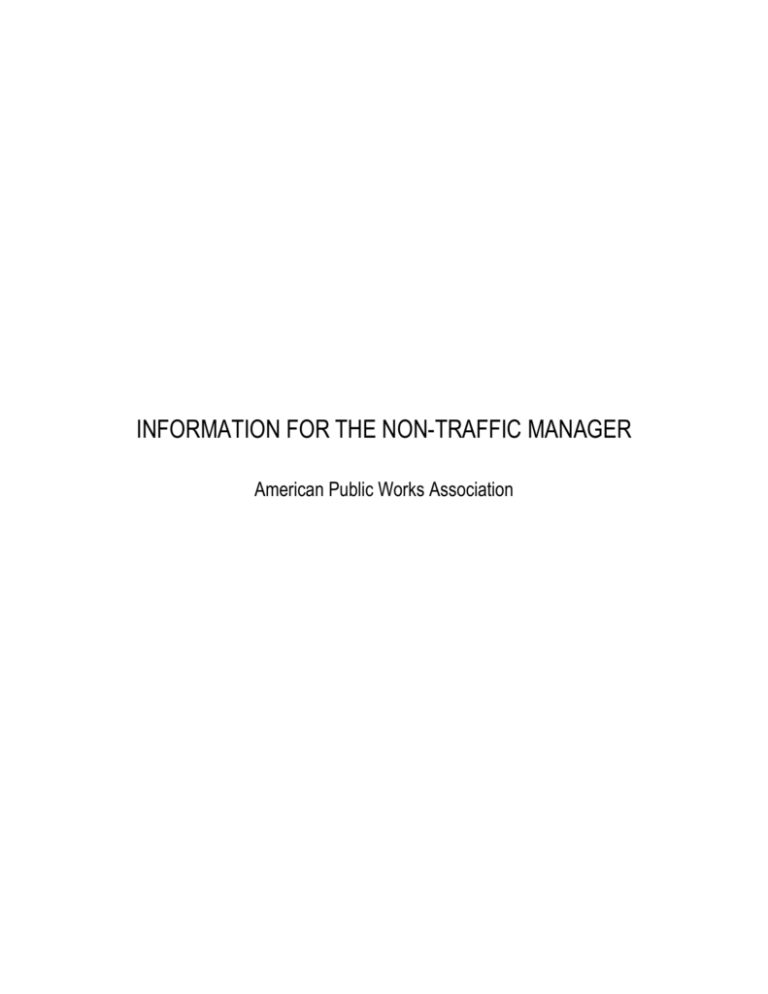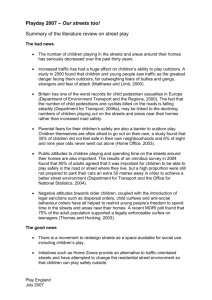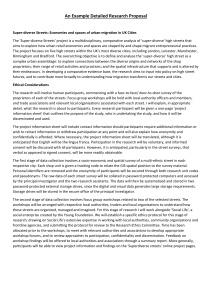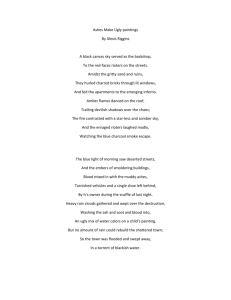Technical PR Booklet - The Freelance Exchange of Kansas City
advertisement

INFORMATION FOR THE NON-TRAFFIC MANAGER American Public Works Association TABLE OF CONTENTS FUNDING ...........................................................................................................................1 How Are Transportation Projects Funded? How Is It Determined Which Streets Will Be Repaved? Why Do Transportation Projects Cost So Much? SPEED .................................................................................................................................2 What Is Traffic Calming? What Is Speed? How Are Speed Limits Determined? How Can We Manage Speed Effectively? TRAFFIC CONTROL DEVICES ....................................................................................4 How Do You Determine When a Traffic Signal Is Needed? Don’t Traffic Signals Slow Down Traffic? Why Can’t You Synchronize All The Traffic Lights? Whey Can’t We Have a Stop Sign Installed at an Intersection Near My Neighborhood? How Do You Determine Where to Place Pedestrian Crossings? When Is a Flashing Beacon Needed? When Is a Left Turn Phase (Green Arrow) Needed at a Signal? Why Can’t You Install a Left Turn Lane? What Do the Warning Signs, Pavement Markings, and Flashing Lights Mean at a Railroad Crossing? What Is a Roundabout and How Should You Drive It? STREET AND PROJECT CONSTRUCTION ...............................................................7 Is Anyone Regulating the Street Cuts Made by Telecommunication Companies? What Is Access Management? MISCELLANEOUS ..........................................................................................................8 Should the City Street System Have a Designated Truck Route? How Is Snow Removal Prioritized? INFORMATION FOR THE NON-TRAFFIC MANAGER Funding How are transportation projects funded? Transportation projects are funded primarily through the local community’s capital improvement program. The capital improvement program is composed of designated funds from local revenues, and sometimes state revenues and federal grant monies. These funds are drawn from a variety of sources such as property taxes, road tolls, fuel taxes, sales taxes, advertising space on public facilities, state lotteries, municipal bonds, and special project taxes. Other possible but less frequent sources of funding are private developer contributions. How is it determined which streets will be re-paved? Streets are prioritized in order of need. Generally, the streets that are in the worst condition will be given the highest priority. Nevertheless, a number of additional factors are also considered. These include the age of the street, the traffic volume, the weight of the traffic, the number of visible cracks, available funding, and fairness-to-the-taxpayer concerns. This does not mean that streets in poor condition will automatically be repaved first. The long-range street planning of a jurisdiction will also influence repaving. For example, studies have proven that it is more economical to maintain streets that are already in fair or better condition first. This prevents them from deteriorating into poor condition or worse, at which point the cost of repair is significantly higher. Thus, there is a strong financial incentive to maintain streets because the cost to rebuild streets is much higher than the cost of ongoing maintenance. Why do transportation projects cost so much? Transportation projects are expensive because they involve significant expenditures for labor and material. The Davis-Bacon Act requires the payment of 1 prevailing wage rates to all laborers and mechanics on major Federal construction projects. Transportation projects involve much more than just what is seen as the end result (the street surface, the traffic signal, the bridge, etc.). There are costs associated with environmental requirements, governmental processes, community involvement processes, meeting local and historical codes, and acquisition of rights-of-way. To ensure that the most qualified contractors perform transportation projects, a detailed Qualifications Based Selection (QBS) process is followed. In this process, prospective contractors are carefully screened and evaluated. The goal is to identify the best possible contractor for a particular job. With QBS although price is important, it is not the absolute or determining issue. In the final analysis, paying more for a contractor to perform a quality job is a wiser use of money than simply trying to identify the lowest bidder. The issue of transportation project costs raises additional questions. For example, “Why isn’t anyone working on such a pretty day?” First, transportation projects often use specialists who may be busy at other construction sites. Second, sometimes there are delays in the delivery of needed material. Third, there is a legitimate need to allow construction materials (such as concrete) to cure properly before additional work can occur. Another question raised is, “Why are there a lot of people standing around and only a couple people are working?” First, some of the people may be inspectors. Second, some of the people may be waiting for a particular job activity to be completed before they can proceed with their work. Some weather-related delays are unseen to the public. For example, asphalt concrete will not cure properly if there is too much moisture or if the temperature is too low. Speed What is traffic calming? Traffic calming is the actions taken to diminish the negative effects of vehicles using streets. These negative effects include vehicles speeding, vehicles cutting through neighborhood streets to avoid congested major streets, traffic noise, aesthetics, and safety risks for pedestrians, cyclists, and other motorists. There is a wide variety of traffic calming techniques. In some cases, targeted enforcement is effective. Targeted enforcement can be used for specific problem areas. For example, speeding, failure to stop for stop signs, and turn restriction violations can be addressed by targeted enforcement. Targeted enforcement may also include photo radar and neighborhood watch programs. Another traffic calming approach involves signing and marking. For example, speed limit signs, turn prohibition signs, marked pedestrian crossings, and striped bicycle lanes are sometimes effective traffic calming tools. Other situations may require parking restrictions, truck restrictions, and converting some two-way streets to one-way streets. 2 Traffic calming might also involve making geometric changes to existing streets. Examples of this include roadway narrowing, traffic circles, speed humps, and traffic diverters. Finally, traffic calming objectives are sometimes met with the aid of landscaping, street furniture, and public awareness efforts. What is speed? Fundamentally, speed is the vehicle’s distance traveled over time. Speed, however, can have different meanings to different people. For the motorist who is trying to navigate across town during rush hour, speed means quickly and conveniently arriving at his destination. For the resident who believes that vehicles are traveling too fast in his neighborhood, speed represents a safety concern. How are speed limits determined? Speed limits are set by the recommendations of traffic engineers based on design criteria. Law enforcement or public safety officials then make recommendations to the city council, which must then approve these recommendations. Factors considered include the prevailing speeds on a street, visibility restrictions, roadway conditions, and accident rates. Generally, a safe and reasonable speed limit is set at or below the speed at which 85% of motorists drive (based on traffic monitoring). Interestingly, studies have repeatedly demonstrated that motorists tend to drive at a speed that they judge to be safe, regardless of posted speed limits. Sometimes the approved speed limit on a street may be faster than what residents want. In these situations, the public safety officials or the town council must be prepared to justify their decision. How can we manage speed effectively? Anyone driving over the speed limit is speeding. Law enforcement officials are directly responsible for addressing these violations. Techniques used may include traditional police enforcement, photo radar, and the use of electronic speed signs or trailers. In managing speed effectively, it is important to guard against any quick, yet inaccurate, solutions. For example, if stop signs are installed to control speed, people tend to speed up significantly between the stop signs to “make up” time. This is not truly addressing the speed issue. Additional items that facilitate effective speed management are public awareness efforts and traffic calming. Also more recently, there is a trend to design new developments and neighborhoods with fewer and shorter straight aways. 3 WHAT IS A WARRANT? Traffic control devices cannot automatically be installed just because one or more citizens or businesses are making a request. Various criteria related to traffic flow, safety, costs, federal and state standards, local ordinances, and street design must be examined. Warrants are the official documents describing the criteria that are used to determine the justification for installing a traffic control device. Warrants are developed in jurisdictions consistent with the warrants already established by the state. Many states are already consistent with the national standards specified in the 2001 edition of Manual on Uniform Traffic Control Devices. For any traffic control device to be installed, it must first satisfy one or more warrants. These warrants identify criteria such as the need to assign right-of-way to conflicting traffic, engineering standards, sight distance, technical analysis, traffic volumes, potential and actual number of accidents, and space for pedestrians. Traffic Control Devices How do you determine when a traffic signal is needed? The decision to install a traffic signal is based on engineering assessments derived from national safety standards. Criteria include the need to assign right-of-way to conflicting traffic, engineering standards, sight distance, technical analysis, traffic volumes, potential and actual number of accidents, and space for pedestrians. These criteria are called warrants. For a traffic signal to be authorized it must meet at least one warrant. Therefore, if a traffic signal is installed without being under a warrant, it can actually create a public safety concern. An engineering study is also required to evaluate the efficacy of the proposed traffic signal. When a traffic control device would enhance traffic flow and/or safety, the local jurisdiction puts the device on a priority list pending funding decisions. Satisfying the warrants does not automatically guarantee that a traffic signal is a good idea. The engineering study and analysis will clarify the issue. This subsequent study may reveal additional factors or conditions that would recommend against the installation of a traffic signal. Don’t traffic signals slow down traffic? When trying to navigate quickly across town, it can seem like that is all they accomplish. Nevertheless, it is important to understand that if all traffic signals were eliminated, traffic movement would be much slower, more difficult, and less safe. 4 The purpose of a traffic signal is to assign right-of-way for traffic on each of the vehicle legs as well as to assure that pedestrians may cross streets safely. Traffic signals impose an orderly, systematic, and safe coordination to all the traffic at an intersection. This greatly reduces accident risk. Normally, traffic signals are timed so that the overall delay that motorists would otherwise experience is reduced. It is true that on a major street there could be delays, while on a side street there would be fewer delays. Therefore, although traffic signals do slow down traffic, they do so in an orderly, systematic manner. This significantly improves traffic flow and safety. Why can’t you synchronize all the traffic lights? Synchronizing all the traffic lights is not always possible. It depends on the geometry of the street system, pre-existing traffic signal systems, and the distances between cross streets. Normally on a one-way street, the signals can be synchronized. Some neighborhoods may have very symmetrical, patterned street layouts with very regular intersections. In these situations, it is easier to time more of the signals for optimum traffic flow. In other neighborhoods, the street layout might be less symmetrical with more irregular intersections. In these situations, it is more difficult to time more of the signals for optimum traffic flow. In signals that become part of systems, the signals are usually coordinated so that there is a certain amount of progression on major streets. Ultimately all of these systems are then interconnected as traffic management centers which endeavor to identify the best timing for all traffic signals. Because of spacing and timing, difficulties do arise when trying to retrofit traffic signals into an existing street layout. In addition, because of various levels of traffic systems and technology, it might be impossible to integrate some traffic signals into a traffic management center. These traffic signals would remain isolated. Why can’t we have a Stop sign installed at an intersection near my neighborhood? We might be able to, if it is a smart solution to the problem. Of course, any given situation would have to be studied to see if a warrant was satisfied. Low-volume, residential streets normally do not need stop signs. Over-signing streets will not add safety or improve traffic flow. In those cases, they are a waste of tax money. Stop signs work well to assign right-of-way at busier intersections. Nevertheless, an overuse of stop signs will cause people to tend to do rolling stops or perhaps not stop at all. If you have a series of these in a neighborhood, the driver may develop an expectation that there will be no cross traffic, and then collide with a vehicle or a pedestrian at a future intersection after he rolls through the stop sign. Therefore, what is happening in these circumstances is that drivers are disrespecting stop signs, thereby, making them less effective. 5 Thus, stop signs have their important purpose, but they are not the answer for every traffic situation. How do you determine where to place pedestrian crossings? Marked crosswalks are installed based on a number of important considerations. Careful analysis is performed because studies have shown that there is a tendency for pedestrians to assume that they are in a position of safety when using a marked crosswalk. The goal is to identify the safest location for the pedestrian to cross. One of the most critical items to explore is the sight distance of the crosswalk. For safety, the motorist must be able to see the pedestrian, and the pedestrian must be able to see the motorist. Unfortunately, not every driver will respect crosswalks and some drivers may be unfamiliar with the area and thus ignore a marked crosswalk. Crosswalk consolidation is another important issue. It is important to consolidate crosswalks as much as possible so that motorists are not unnecessarily distracted with numerous crosswalks. Yellow, marked crosswalks for schools are installed to accommodate the suggested route to school. The school determines this route after an appropriate level of study by the responsible jurisdictions. When is a flashing beacon needed? A flashing beacon is used when additional warning is needed for motorists. It can be used to warn of a crossing, an especially hazardous condition, a signal ahead, school crossing zones, the entrance to a fire station, or the end of a highway. Flashing beacons are used very rarely so that their effectiveness is not diminished. When is a left turn phase (green arrow) needed at a signal? A left turn phase (green arrow) is used in a particular location when the peak or normal traffic flow creates an intolerable delay in permitting the left turn, or when making the left turn without it would compromise safety. They are not needed if the delay imposed is reasonable. As with the installation of any traffic control device, the appropriate warrants would have to be satisfied. Why can’t you install a left turn lane? Oftentimes there is not enough space (the road is too narrow). A left turn lane should only be installed if there is an intolerable delay in permitting the left turn, or when making the left turn without it would compromise safety. (Also refer to above question, When is a left turn phase (green arrow) needed at a signal?) 6 What do the warning signs, pavement markings, and flashing lights mean at a railroad crossing? These are all devices to warn the motorist of an approaching railroad crossing. Depending on the sequencing and combination of these devices, they will also warn the motorist when it is not safe to proceed due to a train or an approaching train. The number and variety of these devices are based on the volume of vehicles and trains at the intersection. For example, cross buck signs and pavement markings are used to passively warn a motorist that he is approaching a railroad crossing. A higher level of warning is provided by the addition of bells and flashing lights. Finally, the highest level of warning (and traffic regulation) is provided by all of the above plus gates to stop traffic. What is a roundabout and how should you drive it? A roundabout (also called a rotary or traffic circle) is a circle at an intersection. The intention is to eliminate all left turns, assign right-of-way, minimize delays at stop signs and traffic signals, and calm traffic. Roundabouts are typically much safer than conventional intersections. Upon entering the roundabout, the motorist should yield to the traffic already present. The motorist needs to move to the far left-hand lane while navigating the roundabout. Once he has identified the desired exit, he needs to carefully move to the far right-hand lane, being careful to watch for other vehicles. He should safely exit to the right upon reaching his desired street. Street and Project Construction Is anyone regulating the street cuts made by telecommunication companies? Yes, the local jurisdiction’s public works or codes enforcement department is responsible to issue encroachment permits on the public right-of-way. This provides a measure of monitoring and regulation. Recent federal legislation has also attempted to address this issue by imposing tighter regulation. This is a serious issue because utilities at risk may include electric, sewer, water, gas, computer, traffic loop technology, and telephone. Any incorrect cuts can negatively affect many individuals and businesses. What is access management? Access management is the review, approval, design, and operation of all points of access to a section of road. This includes all private and public driveways and streets. 7 The intention of access management is to make certain that as each new access point is added to a road, the safety and function of that road will not be impeded. Access management includes issues such as location of the access point and traffic volume. Miscellaneous Should the city street system have a designated truck route? Depending on the circumstances, there are two different answers to this question: 1). The city already has a designated truck route. Perhaps there is a need to make sure that the signs are visible and clear, or perhaps a reevaluation of the truck route is needed. 2). The city does not have a designated truck route. If the citizen can explain why the city needs a designated truck route then the case can be evaluated. It may be that based on weight, volume, traffic patterns, and current traffic problems, a designated truck route is needed. How is snow removal prioritized? The overall goal is to plow all streets as soon as possible after a storm. Specific streets and locations are prioritized according to various factors such as street or highway classification, traffic volume, and emergency services. Emergency routes needed by the police, the fire department, and ambulances are given the highest priority. Next in priority would be the heaviest volume streets. Streets of lower traffic volume are next in priority. Consideration is also given to critical public services such as hospitals and airports. 8 INFORMATION FOR THE NONTRAFFIC MANAGER (2001) READER FEEDBACK FORM Name ______________________________ Title ______________________________ Company or Office _______________________________________________________ Address ________________________________________________________________ City ___________________________ State _________________ Telephone _________________________ Zip ___________ Email _____________________________ Your feedback is extremely important to us for future editions of this booklet. Please provide your assessment for each area itemized below: RATE EACH SECTION Funding Speed Traffic Control Devices Street and Project Construction Miscellaneous Excellent Good Average Fair Poor RATE EACH QUALITY Organization and layout Appearance Ease of use Completeness of information Meets your needs Easy to understand Excellent Good Average Fair Poor RATE OVERALL BOOKLET Booklet overall rating Excellent Good Average Fair Poor Additional comments Please return this form to: American Public Works Association 2345 Grand Boulevard, Suite 500 Kansas City, Missouri 64108-2625 If you wish to fax: 816-472-1610 9




